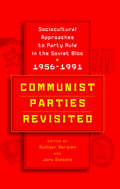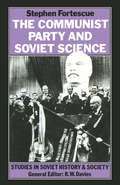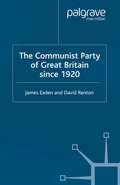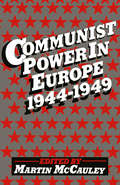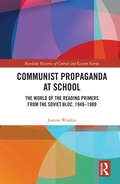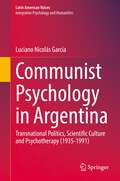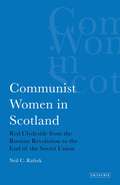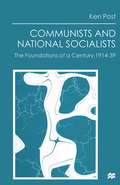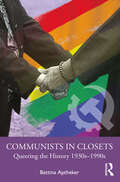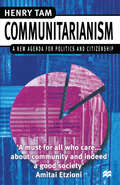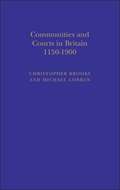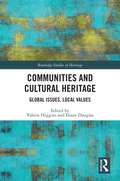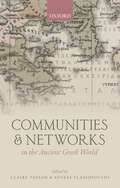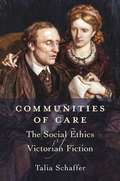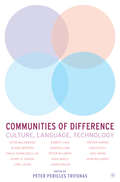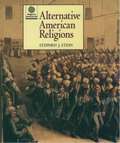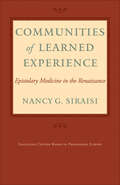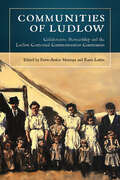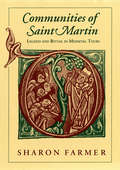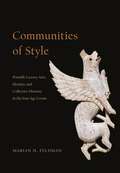- Table View
- List View
Communist Parties Revisited: Sociocultural Approaches to Party Rule in the Soviet Bloc, 1956-1991
by Rüdiger Bergien and Jens GiesekeThe ruling communist parties of the postwar Soviet Bloc possessed nearly unprecedented power to shape every level of society; perhaps in part because of this, they have been routinely depicted as monolithic, austere, and even opaque institutions. Communist Parties Revisited takes a markedly different approach, investigating everyday life within basic organizations to illuminate the inner workings of Eastern Bloc parties. Ranging across national and transnational contexts, the contributions assembled here reconstruct the rituals of party meetings, functionaries’ informal practices, intra-party power struggles, and the social production of ideology to give a detailed account of state socialist policymaking on a micro-historical scale.
The Communist Party and Soviet Science: (pdf) (Studies in Soviet History and Society)
by Stephen FortescueThe Communist Party of Great Britain Since 1920
by J. Eaden D. RentonA new single volume history of the Communist Party of Great Britain examining the party from its foundations in 1920 to its demise in the early 1990s. Drawing on original research and a reading of specialist texts, the authors analyze the rise and fall of the party and evaluate its role on the left of British politics. Whilst sympathetic to the ideals and commitment of many British communist activists, the book is sharply critical of much of the actual practice of the party.
Communist Power in Europe, 1944-49: (pdf) (Studies In Russian And East European History And Society Ser.)
by Mary McCauleyCommunist Propaganda at School: The World of the Reading Primers from the Soviet Bloc, 1949-1989 (Routledge Histories of Central and Eastern Europe)
by Joanna WojdonCommunist Propaganda at School is based on an analysis of reading primers from the Soviet bloc and recreates the world as presented to the youngest schoolchildren who started their education between 1949 and 1989 across the nine Eastern European countries. The author argues that those first textbooks, from their first to last pages, were heavily laden with communist propaganda, and that they share similar concepts, techniques and even contents, even if some national specificities can be observed. This volume reconstructs the image of the world presented to schoolchildren in the first books they were required to read in their school life, and argues that the image was charged with communist propaganda. The book is based on the analysis of over sixty reading primers from nine countries of the Soviet bloc: Albania, Bulgaria, Czechoslovakia, the German Democratic Republic, Hungary, Poland, Romania, the Soviet Union and Yugoslavia from the period. Written with simplicity and straightforwardness, this book will be a valuable resource, not only to international academics dealing with the issues of propaganda, censorship, education, childhood and everyday life under communism in Eastern and Central Europe, but can also academics dealing with education under communism or with the content of primary education. It also brings educational experiences of the Soviet bloc to international researchers, in particular to researchers of education under totalitarian and authoritarian regimes.
Communist Propaganda at School: The World of the Reading Primers from the Soviet Bloc, 1949-1989 (Routledge Histories of Central and Eastern Europe)
by Joanna WojdonCommunist Propaganda at School is based on an analysis of reading primers from the Soviet bloc and recreates the world as presented to the youngest schoolchildren who started their education between 1949 and 1989 across the nine Eastern European countries. The author argues that those first textbooks, from their first to last pages, were heavily laden with communist propaganda, and that they share similar concepts, techniques and even contents, even if some national specificities can be observed. This volume reconstructs the image of the world presented to schoolchildren in the first books they were required to read in their school life, and argues that the image was charged with communist propaganda. The book is based on the analysis of over sixty reading primers from nine countries of the Soviet bloc: Albania, Bulgaria, Czechoslovakia, the German Democratic Republic, Hungary, Poland, Romania, the Soviet Union and Yugoslavia from the period. Written with simplicity and straightforwardness, this book will be a valuable resource, not only to international academics dealing with the issues of propaganda, censorship, education, childhood and everyday life under communism in Eastern and Central Europe, but can also academics dealing with education under communism or with the content of primary education. It also brings educational experiences of the Soviet bloc to international researchers, in particular to researchers of education under totalitarian and authoritarian regimes.
Communist Psychology in Argentina: Transnational Politics, Scientific Culture and Psychotherapy (1935-1991) (Latin American Voices)
by Luciano Nicolás GarcíaThis book presents an intellectual history of the reception of Soviet psychology in Argentina as part of the communist scientific culture promoted by the Argentine Communist Party. This research reconstructs the material conditions, the political conjunctures and disciplinary disputes that allowed the international circulation of the works and ideas of Ivan Pavlov and Lev Vygotsky, and analyzes how pavlovism and vygotskianism impacted psychology, psychiatry and the wider mental health field in Argentina between 1935 and 1991.Starting on the 1930s, a group of professionals, scientists and intellectuals who belonged to the Argentine Communist Party introduced Soviet psychology in Argentina as an effort to promote the philosophical and political principles of Marxism-Leninism in Argentinean psychological and psychiatric academic circles, as well as in mental health institutions. This book shows how the efforts of this group contributed to the diffusion of communist scientific ideas and practices in South America as part of a transnational circuit of communist scholars and intellectuals that included France, Spain and the USA, which fostered scientific exchange and politicized science during the years of antifascist struggle and the Cold War. Communist Psychology in Argentina: Transnational Politics, Scientific Culture and Psychotherapy (1935-1991) will be of interest to historians of psychology and psychiatry concerned with the study of the relationship between Marxism and psychology in the 20th century, as well as to historians of science in general attentive to the study of the circulation of scientific ideas, as the book reconstructs the networks of the international communist movement as an effort to provide a scientific basis for the development of a socialist program in different parts of the world.
Communist Women in Scotland: Red Clydeside from the Russian Revolution to the End of the Soviet Union (International Library of Political Studies)
by Neil C. RafeekScotland, and especially the industrial conurbation surrounding Glasgow, played a pivotal role in radical politics in the twentieth century. The protesters challenged the capitalist social order and, on occasion, the state itself, thus earning the tag 'Red Clydeside'. However, the role of women in this movement has been marginalised. In this original and meticulously researched study, Neil Rafeek addresses this gap in the literature, critically examining the experience of women in the Communist Party in Scotland, from the formation of the Party in 1920 to the end of a century of tumultuous upheaval and social and political change. Rakeek engages critically with many of the key issues of debate, traversing gender relations within the Party, the importance of the Socialist Sunday School and other formative influences on political consciousness as well as the involvement of communist women in the world wars, the developing struggle for women's rights, the 1960s, the revolutions and anti-Vietnam war/nuclear weapons campaigns. This book privileges the memories and voices of participants, and relies upon new oral interview evidence, accumulated by the author, from those women who lived through and were directly involved in these events. Rafeek describes women's experiences of meeting leading international personalities of the era: Khrushchev, Gagarin, Tereshkova, Castro and Ceauescus. Using rich and evocative personal testimony blended with sensitive analysis, Rafeek shows the idealistic socialist motivation behind the establishment of 'Red Clydeside' and the subsequent growing strains and discord in Communism and the labour movement generally, internationally and in Scotland.
Communists and National Socialists: The Foundations of a Century, 1914–39
by Ken PostA study of the Russian Revolution of 1917 and the coming to power of the Nazis in Germany in 1933 in light of the marxist proposition that revolution would come in advanced capitalist societies. The implications of the actual cases for the theory are drawn out, and an original theorization of capitalist crisis combining economic and political factors is put forward.
Communists in Closets: Queering the History 1930s–1990s
by Bettina ApthekerCommunists in Closets: Queering the History 1930s–1990s explores the history of gay, lesbian, and non-heterosexual people in the Communist Party in the United States. The Communist Party banned lesbian, gay, bisexual, and transgender (LGBT) people from membership beginning in 1938 when it cast them off as "degenerates." It persisted in this policy until 1991. During this 60-year ban, gays and lesbians who did join the Communist Party were deeply closeted within it, as well as in their public lives as both queer and Communist. By the late 1930s, the Communist Party had a membership approaching 100,000 and tens of thousands more people moved in its orbit through the Popular Front against fascism, anti-racist organizing, especially in the south, and its widely read cultural magazine, The New Masses. Based on a decade of archival research, correspondence, and interviews, Bettina Aptheker explores this history, also pulling from her own experience as a closeted lesbian in the Communist Party in the 1960s and ‘70s. Ironically, and in spite of this homophobia, individual Communists laid some of the political and theoretical foundations for lesbian and gay liberation and women’s liberation, and contributed significantly to peace, social justice, civil rights, and Black and Latinx liberation movements. This book will be of interest to students, scholars, and general readers in political history, gender studies, and the history of sexuality.
Communists in Closets: Queering the History 1930s–1990s
by Bettina ApthekerCommunists in Closets: Queering the History 1930s–1990s explores the history of gay, lesbian, and non-heterosexual people in the Communist Party in the United States. The Communist Party banned lesbian, gay, bisexual, and transgender (LGBT) people from membership beginning in 1938 when it cast them off as "degenerates." It persisted in this policy until 1991. During this 60-year ban, gays and lesbians who did join the Communist Party were deeply closeted within it, as well as in their public lives as both queer and Communist. By the late 1930s, the Communist Party had a membership approaching 100,000 and tens of thousands more people moved in its orbit through the Popular Front against fascism, anti-racist organizing, especially in the south, and its widely read cultural magazine, The New Masses. Based on a decade of archival research, correspondence, and interviews, Bettina Aptheker explores this history, also pulling from her own experience as a closeted lesbian in the Communist Party in the 1960s and ‘70s. Ironically, and in spite of this homophobia, individual Communists laid some of the political and theoretical foundations for lesbian and gay liberation and women’s liberation, and contributed significantly to peace, social justice, civil rights, and Black and Latinx liberation movements. This book will be of interest to students, scholars, and general readers in political history, gender studies, and the history of sexuality.
Communitarianism: A New Agenda for Politics and Citizenship
by Henry TamAlthough Communitarianism has a long history, it is only recently that it has emerged to pose a major challenge to the traditional left-right divide in politics and the competing principles of individualism and collectivism. Henry Tam's book provides a broad-ranging and accessible introduction to communitarian ideas and their implications for politics and citizenship drawing on a wide range of international examples and engaging with communitarianism's critics to demonstrate clearly its relevance beyond the United States base of many of its major protagonists.
Communities and Courts in Britain, 1150-1900
by Christopher BrooksThe essays in Communities and Courts in Britain, 1150-1900 all reflect the wider concept of legal history - how legal processes fitted into the social and political life of the community and how courts and other legal processes were used by contemporaries. In doing so they aim both to justify the study of legal history in its own right and to show how legal records, including those of a variety of central and local courts, can be used to further our understanding of a wide range of social, commercial, popular and political history.
Communities and Cultural Heritage: Global Issues, Local Values
by Valerie HigginsCommunities and Cultural Heritage explores the relationship between communities, their cultural heritage and the global forces that control most of the world’s wealth and resources in today’s world. Bringing together scholars and heritage practitioners from nine countries, this book contributes to the ongoing dialogue on community heritage by analysing impediments to full community participation. The underminin of local communities comes at a high price. As the chapters in this book demonstrate, the knowledge embedded within traditional and Indigenous heritage creates communities that are more resilient to environmental and social stressors and more responsive to contemporary challenges such as climate change, environmental degradation, post-disaster recovery and relocation. Cultural heritage practices often fail to capitalise upon local knowledge and traditional skills and undervalue the potential contribution of local communities in finding creative and resourceful solutions to the issues they are confronting. Arguing that the creation of successful community heritage project requires ongoing reflection on the aims, methods, financing and acceptable outcomes of projects, the volume also demonstrates that the decolonization of Western-focussed heritage practices is an ongoing process, by which subaltern groups are brought forward and given a space in the heritage narrative. Reflecting on trends that impact communities and heritage sites across different geographical regions, Communities and Cultural Heritage will be of interest to academics, students and practitioners of cultural heritage,archaeology and anthropology around the world.
Communities and Cultural Heritage: Global Issues, Local Values
by Valerie Higgins Diane DouglasCommunities and Cultural Heritage explores the relationship between communities, their cultural heritage and the global forces that control most of the world’s wealth and resources in today’s world. Bringing together scholars and heritage practitioners from nine countries, this book contributes to the ongoing dialogue on community heritage by analysing impediments to full community participation. The underminin of local communities comes at a high price. As the chapters in this book demonstrate, the knowledge embedded within traditional and Indigenous heritage creates communities that are more resilient to environmental and social stressors and more responsive to contemporary challenges such as climate change, environmental degradation, post-disaster recovery and relocation. Cultural heritage practices often fail to capitalise upon local knowledge and traditional skills and undervalue the potential contribution of local communities in finding creative and resourceful solutions to the issues they are confronting. Arguing that the creation of successful community heritage project requires ongoing reflection on the aims, methods, financing and acceptable outcomes of projects, the volume also demonstrates that the decolonization of Western-focussed heritage practices is an ongoing process, by which subaltern groups are brought forward and given a space in the heritage narrative. Reflecting on trends that impact communities and heritage sites across different geographical regions, Communities and Cultural Heritage will be of interest to academics, students and practitioners of cultural heritage,archaeology and anthropology around the world.
Communities and Networks in the Ancient Greek World
This volume examines the diversity of networks and communities in the classical and early Hellenistic Greek world, with particular emphasis on those which took shape within and around Athens. In doing so it highlights not only the processes that created, modified, and dissolved these communities, but shines a light on the interactions through which individuals with different statuses, identities, levels of wealth, and connectivity participated in ancient society. By drawing on two distinct conceptual approaches, that of network studies and that of community formation, Communities and Networks in the Ancient Greek World showcases a variety of approaches which fall under the umbrella of 'network thinking' in order to move the study of ancient Greek history beyond structuralist polarities and functionalist explanations. The aim is to reconceptualize the polis not simply as a citizen club, but as one inter-linked community amongst many. This allows subaltern groups to be seen not just as passive objects of exclusion and exploitation but active historical agents, emphasizes the processes of interaction as well as the institutions created through them, and reveals the interpenetration between public institutions and private networks which integrated different communities within the borders of a polis and connected them with the wider world.
Communities of Care: The Social Ethics of Victorian Fiction
by Talia SchafferWhat we can learn about caregiving and community from the Victorian novelIn Communities of Care, Talia Schaffer explores Victorian fictional representations of care communities, small voluntary groups that coalesce around someone in need. Drawing lessons from Victorian sociality, Schaffer proposes a theory of communal care and a mode of critical reading centered on an ethics of care.In the Victorian era, medical science offered little hope for cure of illness or disability, and chronic invalidism and lengthy convalescences were common. Small communities might gather around afflicted individuals to minister to their needs and palliate their suffering. Communities of Care examines these groups in the novels of Jane Austen, Charlotte Brontë, Charles Dickens, George Eliot, Henry James, and Charlotte Yonge, and studies the relationships that they exemplify. How do carers become part of the community? How do they negotiate status? How do caring emotions develop? And what does it mean to think of care as an activity rather than a feeling? Contrasting the Victorian emphasis on community and social structure with modern individualism and interiority, Schaffer’s sympathetic readings draw us closer to the worldview from which these novels emerged. Schaffer also considers the ways in which these models of carework could inform and improve practice in criticism, in teaching, and in our daily lives.Through the lens of care, Schaffer discovers a vital form of communal relationship in the Victorian novel. Communities of Care also demonstrates that literary criticism done well is the best care that scholars can give to texts.
Communities of Care: The Social Ethics of Victorian Fiction
by Talia SchafferWhat we can learn about caregiving and community from the Victorian novelIn Communities of Care, Talia Schaffer explores Victorian fictional representations of care communities, small voluntary groups that coalesce around someone in need. Drawing lessons from Victorian sociality, Schaffer proposes a theory of communal care and a mode of critical reading centered on an ethics of care.In the Victorian era, medical science offered little hope for cure of illness or disability, and chronic invalidism and lengthy convalescences were common. Small communities might gather around afflicted individuals to minister to their needs and palliate their suffering. Communities of Care examines these groups in the novels of Jane Austen, Charlotte Brontë, Charles Dickens, George Eliot, Henry James, and Charlotte Yonge, and studies the relationships that they exemplify. How do carers become part of the community? How do they negotiate status? How do caring emotions develop? And what does it mean to think of care as an activity rather than a feeling? Contrasting the Victorian emphasis on community and social structure with modern individualism and interiority, Schaffer’s sympathetic readings draw us closer to the worldview from which these novels emerged. Schaffer also considers the ways in which these models of carework could inform and improve practice in criticism, in teaching, and in our daily lives.Through the lens of care, Schaffer discovers a vital form of communal relationship in the Victorian novel. Communities of Care also demonstrates that literary criticism done well is the best care that scholars can give to texts.
Communities of Difference: Culture, Language, Technology
by P. TrifonasThis book will look at the implications of educational practices in communities that are differentiated by issues of language, culture, and technology. Trifonas argues that a 'community' is at once a gathering of like-minded individuals in solidarity of purpose and conviction, and also a gathering that excludes others. The chapters in this collection will reveal this tension between theory and practice in order to engage the models of community and the theories of difference that support them as a way to teach, to learn, and to know.
Communities of Dissent: A History of Alternative Religions in America
by Stephen J. SteinAlternative religious groups have had a profound influence on American history-they have challenged the old and opened up new ways of thinking about healing, modes of meaning, religious texts and liturgies, the social and political order, and the relationships between religion and race, class, gender, and region. Virtually always, the dramatic, dynamic history of alternative religions runs parallel to that of dissent in America. Communities of Dissent is an evenhanded and marvelously lively history of New Religious Movements in America. Stephen J. Stein describes the evolution and structure of alternative religious movements from both sides: the critics and the religious dissenters themselves. Providing a fascinating look at a wide range of New Religious Movements, he investigates obscure groups such as the 19th-century Vermont Pilgrims, who wore bearskins and refused to bathe or cut their hair, alongside better-known alternative believers, including colonial America's largest outsider faith, the Quakers; 17th- and 18th-century Mennonites, Amish, and Shakers; and the Christian Scientists, Jehovah's Witnesses, Black Muslims, and Scientologists of today. Accessible and comprehensive, Communities of Dissent also covers the milestones in the history of alternative American religions, from the infamous Salem witch trials and mass suicide/murder at Jonestown to the positive ways in which alternative religions have affected racial relations, the empowerment of women, and American culture in general.
Communities of Learned Experience: Epistolary Medicine in the Renaissance (Singleton Center Books in Premodern Europe)
by Nancy G. SiraisiDuring the Renaissance, collections of letters both satisfied humanist enthusiasm for ancient literary forms and provided the flexibility of a format appropriate to many types of inquiry. The printed collections of medical letters by Giovanni Manardo of Ferrara and other physicians in early sixteenth-century Europe may thus be regarded as products of medical humanism. The letters of mid- and late sixteenth-century Italian and German physicians examined in Communities of Learned Experience by Nancy G. Siraisi also illustrate practices associated with the concepts of the Republic of Letters: open and relatively informal communication among a learned community and a liberal exchange of information and ideas. Additionally, such published medical correspondence may often have served to provide mutual reinforcement of professional reputation. Siraisi uses some of these collections to compare approaches to sharing medical knowledge across broad regions of Europe and within a city, with the goal of illuminating geographic differences as well as diversity within social, urban, courtly, and academic environments. The collections she has selected include essays on general medical topics addressed to colleagues or disciples, some advice for individual patients (usually written at the request of the patient’s doctor), and a strong dose of controversy.
Communities of Learned Experience: Epistolary Medicine in the Renaissance (Singleton Center Books in Premodern Europe)
by Nancy G. SiraisiDuring the Renaissance, collections of letters both satisfied humanist enthusiasm for ancient literary forms and provided the flexibility of a format appropriate to many types of inquiry. The printed collections of medical letters by Giovanni Manardo of Ferrara and other physicians in early sixteenth-century Europe may thus be regarded as products of medical humanism. The letters of mid- and late sixteenth-century Italian and German physicians examined in Communities of Learned Experience by Nancy G. Siraisi also illustrate practices associated with the concepts of the Republic of Letters: open and relatively informal communication among a learned community and a liberal exchange of information and ideas. Additionally, such published medical correspondence may often have served to provide mutual reinforcement of professional reputation. Siraisi uses some of these collections to compare approaches to sharing medical knowledge across broad regions of Europe and within a city, with the goal of illuminating geographic differences as well as diversity within social, urban, courtly, and academic environments. The collections she has selected include essays on general medical topics addressed to colleagues or disciples, some advice for individual patients (usually written at the request of the patient’s doctor), and a strong dose of controversy.
Communities of Ludlow: Collaborative Stewardship and the Ludlow Centennial Commemoration Commission
by Fawn-Amber Montoya Karin LarkinFor more than one hundred years, people have come to the Ludlow Massacre Memorial site to remember the dead, to place themselves within a larger narrative of labor history, and to learn about what occurred there. Communities of Ludlow reveals the perseverance, memory, and work that has been done to enrich and share the narratives of the people of Ludlow and the experiences of those who commemorate it. The history of the Ludlow Massacre encompasses the stories of immigrant groups, women, the working-class, and people of color as much as the story of that tragedy, and the continued relevance of these issues creates a need for remembrance and discussion of how to make the events of the Ludlow Massacre available to contemporary society. The book outlines recent efforts to remember and commemorate this important historical event, documenting the unique collaborations in public scholarship and outreach among the diverse group of people involved in marking the 100-year anniversary of the Ludlow Massacre. The chapters relate the tales of the stewards of the Ludlow Massacre—the various communities that rallied together to keep this history alive and show its relevance, including lineal descendants, members of the United Mine Workers of America, historians, archaeologists, scholars, artists, interpreters, authors, playwrights, and politicians. The book also offers tips, strategies, and cautionary tales for practicing engaged public scholarship. The history of the Ludlow Massacre has been told as a tragedy of striking miners in the West that occurred during a turbulent time in US labor relations, but it is so much more than that. Communities of Ludlow explores the intersections of public scholarship, advocacy, and personal experience, weaving these perspectives together with models for practicing public scholarship to illustrate the power of creating spaces for sharing ideas and information in an environment that encourages creativity, open dialogue, public outreach, political action, and alternative narratives. Contributors: Robert Butero, Robin Henry, Michael Jacobson, Elizabeth Jameson, Linda Linville, Matthew Maher, Yolanda Romero
Communities of Saint Martin: Legend and Ritual in Medieval Tours
by Sharon FarmerSharon Farmer here investigates the ways in which three medieval communities—the town of Tours, the basilica of Saint-Martin there, and the abbey of Marmoutier nearby—all defined themselves through the cult of Saint Martin. She demonstrates how in the early Middle Ages the bishops of Tours used the cult of Martin, their fourthcentury predecessor, to shape an idealized image of Tours as Martin's town. As the heirs to Martin's see, the bishops projected themselves as the rightful leaders of the community. However, in the late eleventh century, she shows, the canons of Saint-Martin (where the saint's relics resided) and the monks of Marmoutier (which Martin had founded) took control of the cult and produced new legends and rituals to strengthen their corporate interests.Since the basilica and the abbey differed in their spiritualities, structures, and external ties, the canons and monks elaborated and manipulated Martin's cult in quite different ways. Farmer shows how one saint's cult lent itself to these varying uses, and analyzes the strikingly dissimilar Martins that emerged. Her skillful inquiry into the relationship between group identity and cultural expression illuminates the degree to which culture is contested territory.Farmer's rich blend of social history and hagiography will appeal to a wide range of medievalists, cultural anthropologists, religious historians, and urban historians.
Communities of Style: Portable Luxury Arts, Identity, and Collective Memory in the Iron Age Levant
by Marian H. FeldmanCommunities of Style examines the production and circulation of portable luxury goods throughout the Levant in the early Iron Age (1200–600 BCE). In particular it focuses on how societies in flux came together around the material effects of art and style, and their role in collective memory. Marian H. Feldman brings her dual training as an art historian and an archaeologist to bear on the networks that were essential to the movement and trade of luxury goods—particularly ivories and metal works—and how they were also central to community formation. The interest in, and relationships to, these art objects, Feldman shows, led to wide-ranging interactions and transformations both within and between communities. Ultimately, she argues, the production and movement of luxury goods in the period demands a rethinking of our very geo-cultural conception of the Levant, as well as its influence beyond what have traditionally been thought of as its borders.
